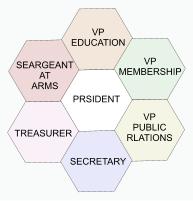|
|
|
|
| Managing Dual Club Members |
| VPE/BCM Help |
|
Useful
Tips from Bethany Richard, DTM, D29, 2020 |
|
|
 |
| Printer friendly copy |
| |
|
Dear Club VPE/BCMs,
Congratulations!
You may have a member in your club who is part of the 5%
of members in the world who is also in another club. Do
you know who they are? They add an extra level of
complexity (read as “opportunity to learn”) to your job
and reaching your club goals. That is why I wrote this,
to help you and them. |
 |
| |
|
|
DEFINITIONS AND EXPLAINATIONS:
VPE – Vice President of Education for a Club, the main
teacher/tracker/approver of club member Pathways levels,
Base Camp – Online program where member
transcripts and online learning are found.
Base Camp Managers (BCM) – Club President,
Secretary, VPE. All three have access to manage/view/approve
basecamp progress of club members. Usually the VPE does all the
BCM work (so I often say VPE when the other two could do the
job). I recommend all three learn how to do this, since VPE
should not approve her/his own educational levels.
Level Completion – VPE can track online
learning of club members by logging into basecamp and refreshing
the data to see what online learning has been accessed. VPE also
tracks projects completed in club to know member progress and
next steps. Ideally the online learning and projects in club
should both be progressing and nearly match. If one happens
without the other – the member may need help. VPE may assist
member by clarifying next steps to complete a level. |
| |
| Required vs Elective Path Projects
– The required projects must be done to complete a level. A
specified minimum number of elective projects are required to
complete the level, although the member may do more if they so
desire. True story: In June a member on Level three had
completed the required and two elective projects and I asked her
if she’d like to complete her level for that year – all she’d
need to do was click to ask for level approval. She was
surprised. She thought she had to do all the electives (eight or
so) and anticipated months to complete the level if I, her VPE,
had not told her. |
| |
| Level Completion Approval –
When a member completes online learning for a level, the BCM (or
other specified as the Find a Club address) receives an email
requesting level approval. Trust but verify. Do not approve
automatically. Check your records, did they do the projects? If
in doubt, contact them. They may have spoken in other clubs or
work venues (and have the evaluations), or they may have just
clicked thru learning in error. Once a path completion is
approved in B ase Camp (that’s step one), remember to |
do step two and go to Club Central. Note: A dual
member does not have to have the Level Completion
Approval by their “Home club” and the claiming for a
club DCP in Club Central done by the same club –
although that is simplest.
Club Officers – The seven club officers
(Pres, Sec, VPE, VPPR, VPM, Tres, SAA) all have access
to Club Central after logging into the Toastmasters
International website. |
 |
|
| |
| Club Central – This access
into club records and function allows the club officers to do
their jobs. For example: add new members, pay dues to TI, change
club contact information, … and to claim educational levels
(completed by club members) for their particular club. It is
vital, especially with dual members, to be absolutely clear what
levels were completed and that they are to be credited to this
club rather than another club. Warning: Club Central does not
interface/communicate with Pathways software. Club Central has
member paths associated with member numbers and Club Central
will list the next level of the path. Click and claim. But you
could click and claim multiple levels in error! There is no
safeguard but your knowledge and your integrity. Notice: A
member will not see the new award in their TI record, nor listed
after their name, until it is claimed in Club Central by some
club officer. |
| |
 |
Dual Members – Toastmasters who are
members of more than one club at a time. As of 2018 only
5% of members worldwide were dual members. Our D29 in
Northern Virginia has a higher percentage, and some
members are even in 3-4 clubs and/or multiple districts
since D27, D29, and D36 are so close to one another. |
| |
|
|
| Who “owns” a Path – The
Toastmaster owns her/his educational path(s). They do not have
to dedicate a path to a particular club. They may add clubs,
drop clubs, step in and out of Toastmasters over the years – and
their path stays with them. Most are in only one club at a time
and that club gets their DCP credit thru Club Central. The dual
member chooses which club may have DCP credit – and I hope they
are a bit strategic about it. (See the last bullet in the
description of DCP) |
| |
| Home Club – This sounds set
in stone, it is not, it’s carved in Jell-O. If a member is in
one club, that is their home club. If they are a dual member,
then they can change their Home club every hour if they wish –
here is how: TI lists a home club above the member’s “go to base
camp” button. That has a drop down that will list all their
clubs (I have four) and that member can pick any of their clubs
as their home club. It does not affect the member’s access to
their own transcript and education. Some dual members change
their home club weekly to match the next upcoming club meeting.
BUT, if your club member designates another club as home club,
then you cannot see them in basecamp with the other club members
– they disappear from your view! …. Until they switch Home club
back to your club. So, VPE, remind your dual member to switch
their Home club to the one club they want to be able to see the
Level Completion Request email from TI. |
| |
| DCP – Distinguished Club
Program. A ten-point system to focus a club on multiple areas of
success. Six of these points are for club members completing
educational levels. |
| |
 |
| |
| DCP Rules – In order for a
club to be distinguished: |
- It must meet minimum membership numbers and earn at
least 5 points in a Toastmaster year.
- 5 or 6 points is Distinguished, 7 or 8 pts is Select
Distinguished, 9 or 10 pts is President’s Distinguished.
- The Toastmaster year runs July 1 thru the following June
30th.
- The club must have at least 20 members in good standing
on June 30 -or- five more than their base membership the
previous year. (so, if they end last year with 12 members,
then they need at least 17 by the end of this year
(12+5=17).
- A club may have DCP credit for only one of each
educational level per member per Toastmaster year. Path is
not important here, only the level. So I can give Club A a
PM1, a MS2, and a DL4 all in the same year (remember Path
does not matter here; I gave a Level 1, 2, and 4) but the
club can’t have credit for both a PM1 and a MS1 from me in
the same year. So, I would give one of the Level 1s to a
different one of my clubs. In fact, I would be strategic,
especially at the end of the year, to distribute my new
educational levels where they are most likely to complete a
point – as in a club that already has 3 other member’s Level
1s , because it takes four Level 1s to complete the point.
|
| Alert: Make sure that every
member education level that was approved in Base Camp, is also
claimed in Club Central by some club. These are two separate
actions. Also note, if a member is only in one club and earns
two different Level 1s – go claim them in Club Central. Sure,
your club will only get credit for one Level 1 from the member
that year, but the member’s TI record will reflect both of their
achievements. This is about the members! |
| |
Dashboard – A Toastmasters
International website DCP status board for your entire
district, accessed thru Club Central or other link.
Daily Reports – Access the Dashboard,
click on Daily Reports in the left column, and get a
list of accessible data. Educational Achievements
(current year) is my favorite to sort by club and check
that all the earned educational achievements by my club
members were claimed in Club Central and therefore show
up in this list. If one is missing, maybe it was not
claimed. You would hate to miss being a distinguished
club because you forgot the Club Central step. You can
also click on the names column to sort and check on your
dual members credits to various clubs. |
 |
| |
|
|
| Educational Designations –
TI’s records will only list your single most recent educational
level after your name in their records unless you are a DTM –
then it will always say DTM. That’s their system rule online. |
- You are welcome to list all your past and current awards
on club websites, nametags, and protocol lists. So you may
be: Geniva Smith, MS4 SR3 or Joseph Sura, CC DL1 Although
technically nothing is added to DTM, some DTMs are
temporarily/informally adding Pathways designations in these
early years to show that they are staying current and
progressing in Pathways.
- A completed path is written with a “5” but pronounced as
“proficient”. So, you would write: Coral Justice, PM5 and
you would announce “Coral Justice, Presentation Mastery
Proficient”. (I got this clarification straight from
Toastmasters International Headquarters this month.)
|
Notice (again): Approval in
Pathways Basecamp IS COMPLETELY INDEPENDENT OF Claiming in Club
Central for DCP.
|
| |
|
Tips for members of more than one club: Track
your own education. Keep a virtual or physical file of
evaluations. |
|
When you are going to complete a level, I
recommend:
|
-
Go into your profile on Toastmasters
website to pick a Home club to receive the email from TI to
approve your Level Completion Request. (I choose the one I
know is most responsive, that I know will get to the
approval quickly).
-
Complete the level, and then keep
that same Home club until you know the approval is complete
(a matter of hours or days). Remember, your
education/path(s) is invisible to any club not currently
designated as your Home club.
-
Immediately email/call the VPE(s) to
alert them to the level completion (the email may go to
their junk mail) and to clarify any completed
projects/speeches that the VPE may not have seen. You may
have spoken in another club or the VPE may have missed a
club meeting when you spoke.
-
You may choose to update all your
VPEs when you achieve a level so that they know and can
celebrate/recognize the achievement – Note: Be very clear
which club will have your new educational level for their
DCP.
|
| DCP Strategy for Dual Members –
Take care of your regular club before your advanced
club. Consider the status of the Dashboard and where
your award will make the most difference to the club’s
status. |
 |
|
| |
| True story: I had an
occasion (2018) when I completed a Level 1 and Club A claimed it
in Club Central for DCP (good), and Club B looked in their Club
Central, saw a Level 2 (the next level on my path) and so they
claimed it (very bad!) At that time TI could not “undo” the
Level 2 so I dug deep and actually completed the Level 2 within
a month (multiple clubs). I did not like that accidental hit on
my integrity and strove to fix it. |
| |
| Dual Members: Help your
VPE/BCM by giving them these sheets. You are an extra challenge
for them. |
| |
|
BETH B. RICHARD·SATURDAY,
AUGUST 29, 2020
|
| |
| |
| |
| |
|
|






